A Powder-Hound's Guide to Vail and Beaver Creek Mountains
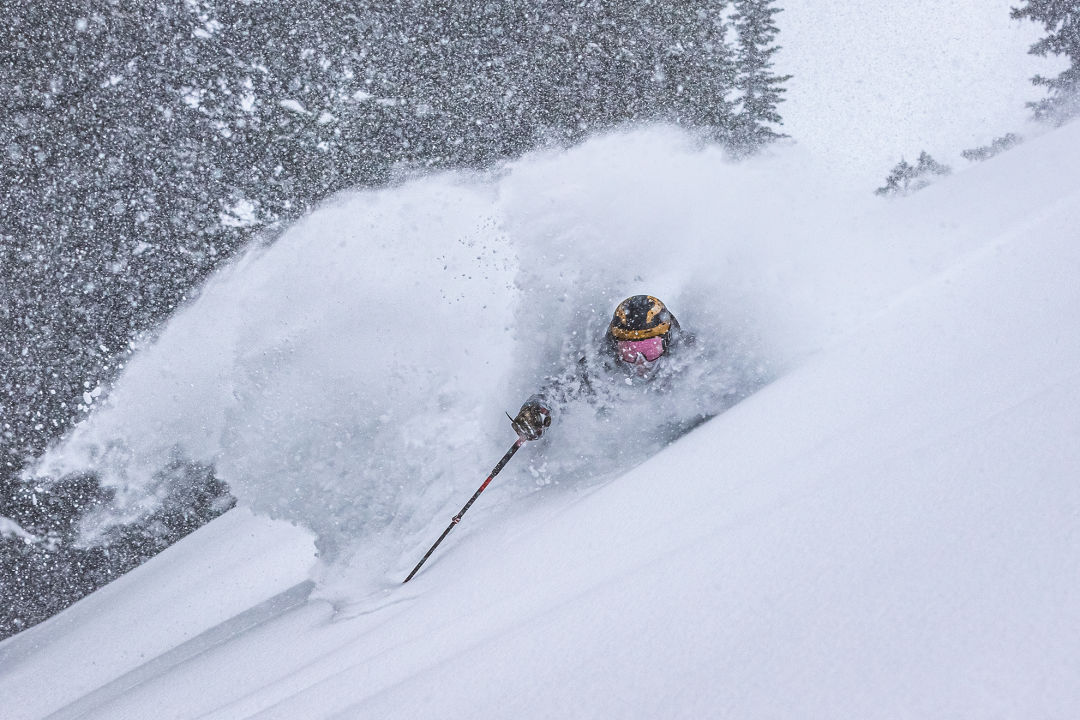
Chris Bivona snorkeling in Vail Mountain's Snag Park.
Image: Scott Bellow
I remember my first visit to the white room. It was the winter of 2010–11, when Vail racked up 459 inches (38 feet!) of snow. Nearly every morning, I’d jump out of bed and stuff my feet into my sometimes still-damp boots and shuffle down to the bus stop at the bottom of Chamonix Lane in West Vail. The town bus, windows completely fogged, would be as packed with skiers and snowboarders as a New York City subway car at rush hour by the time we pulled into the Transportation Center, and I’d join the horde as it clomped up Bridge Street bound for the labyrinth of lift rides that would transport us into the snow globe beyond. As a transplant from the East Coast, I had never experienced champagne powder like Vail’s, and I remember vividly my first turns off Chair 11 (Northwoods Express Lift) that felt like I had ascended into
heaven as waves of snow rolled over my head.
The mythical white room every powder hound chases isn’t a place, it’s a moment. When you’re carving down a run and—poof—like the explosive flash on an old-fashioned camera, you hit a pocket of snow so deep you’re enveloped in white, a plume that boils and roils and rolls around you, envelops you so completely you feel like you’re surfing through the barrel of an ethereal wave. Vail and Beaver Creek typically average about 300 inches of snow (the 2010–11 winter season was record-setting), but on any given day that the snowstakes at both resorts, or either, register six inches or more, it’s time to call in sick (cough! cough!) or at least show up late for work after a few blissful turns in the white room.
Last winter, Colorado’s high country registered a record-breaking 16 consecutive days of snowfall in March that—along with producing historic avalanches that roared onto I-70 and ripped thousands of trees from newly formed chutes cleared like ski runs—yielded sublime conditions on Vail and Beaver Creek mountains. After each powder dump, we dispatched action sports photographer Scott Bellow to document a crew of local, semi-pro skiers and snowboarders seizing that indescribable moment, illustrating our go-to guide to Vail and Beaver Creek powder stashes that—when conditions are right—should be guaranteed to put a perma-grin on your face as you’re floating on snow that’s lighter than air, humming that quintessential Eric Clapton tune (“In the white room....”).
VAIL MOUNTAIN POWDER STASHES
Despite what you might hear in the line for Gondola One on a particularly busy Saturday morning, not all of Vail Mountain’s snow is found in Blue Sky Basin (although, you won’t be disappointed if a tour de Blue Sky is in your powder day plan). With more than 5,000 acres of terrain, there are tons of powder stashes to be found in Vail’s Back Bowls (and on the frontside!). The only dilemma is where to go first....
Highline
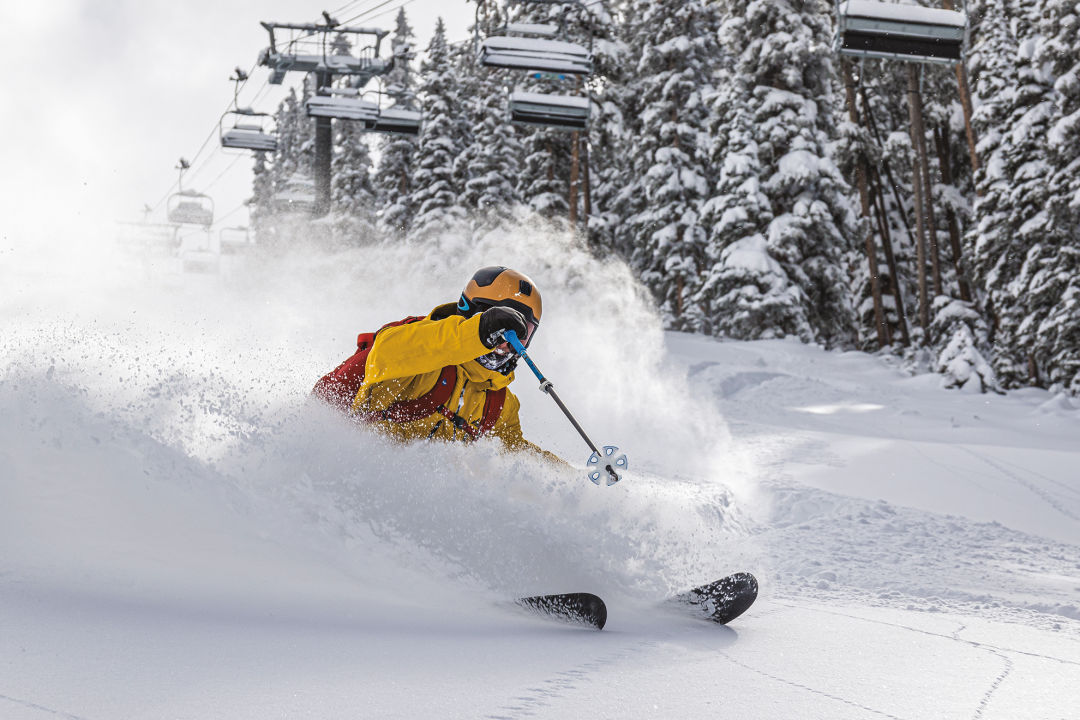
Bryan Finocchiaro on Highline
Image: Scott Bellow
On a powder day, there are a few good reasons to head directly to Chair 10 (Highline Express Lift)—the first being that you can typically avoid the out-of-the-maze Gondola One lift line if your goal is to be among the first to make it back to Blue Sky Basin. But after a few laps, you may opt to forgo Blue Sky altogether; mogul field Highline is actually pretty heavenly (and easier on the knees) when it’s coated in a foot of snow—just be ready for plenty of hoots and hollers coming from the lift line above you—and neighboring run Blue Ox provides some steep, un-treed turns while you’re contemplating your next moves (just check the grooming report, as Blue Ox is sometimes groomed).
How to get there: The most direct route (and your best strategy when the Gondola One lift line overflows onto Bridge Street) is to clomp over to Golden Peak and ride Chair 6 (Riva Bahn Express) to the lift’s midstation. Exit there with the Ski Club Vail kids and their coaches, then follow the cat track skier’s left of the lift to the base of Chair 10. From Patrol Headquarters (PHQ) at the top of the mountain, follow Swingsville to Prima, then the Transmontane or Skid Road cat tracks to the base of Chair 10.
Other Frontside Powder Runs

Gus Gruner in Mudslide, the frontside's infrequently skied experts-only technical terrain
Image: Scott Bellow
Snag Park
We might get some flak from locals for giving up Snag Park, a steep, gladed powder stash that’s often ignored by intermediate skiers content with lapping Northwoods, but truth be told, Snag’s no secret (it’s signed!), especially when you’re warming up your knees on your way to somewhere else.
How to get there: From PHQ, follow the ridgeline between Sleepytime and Timberline catwalks toward Sourdough. Just past the entrance of Northwoods, drop into the trees and carve a few turns (in the unsigned section often referred to as Upper Snag), then cross Timberline catwalk into the lower section, or just skip Upper Snag and follow Timberline and signs advertising Snag Park.
Riva Ridge
It’s hard to qualify Riva Ridge as a stash since everyone knows about it (it’s the longest, and some argue finest, run on Vail Mountain), but that doesn’t mean you should count it out on a powder day. Especially when everyone else is beelining to the Back Bowls, you may have the run to yourself, a magical experience, especially with all that powder cushioning the typically rock-hard, Volkswagen-size moguls. And if you’re into tree skiing, make sure you duck into Riva Glade, a thick grove filled with pines and steeps between Riva Ridge and Christmas near the top of the run (you’re welcome).
How to get there: Exit skier’s left from the top of Chair 4 (Mountaintop Express Lift), then follow the fall line past Swingsville and Christmas until you see signs for Riva Ridge straight ahead.
Experts Only
Looking for some of Vail Mountain’s steepest, most technical, double-black diamond terrain? Stay on the frontside—The Pump House, The Narrows, Mudslide, and Frontside Chutes are all accessible from Mid-Vail. Keep in mind: all four runs don’t open until later in the season, and they’re typically closed when there’s too much snow (there’s no way for ski patrol to mitigate avalanche hazards in these steeps, especially so close to Gondola One, which runs roughly above all four trails). Should you happen to ski by on the rare day they’re open, before you drop in, ask yourself if you are ready (and able) to take on steep drops, thick trees, and tons of snow. There’s also no cat track to save you if you get cold feet mid-run. If you accept all the above (and the conditions are right), a powdery nirvana awaits.
How to get there: From Mid-Vail, follow Gitalong Road cat track as it winds around toward Chair 2 (Avanti Express Lift). You’ll first see a sign on your right for The Pump House. If you continue on the cat track toward the Black Forest Racecourse (on your left) you’ll see signs on skier’s right indicating drop-ins for The Narrows, Mudslide, and Frontside Chutes just after Waffle Way. If you end up at the bottom of Chair 2, you’ve just missed it; head up Chair 2 for a second chance.
The Back Bowls
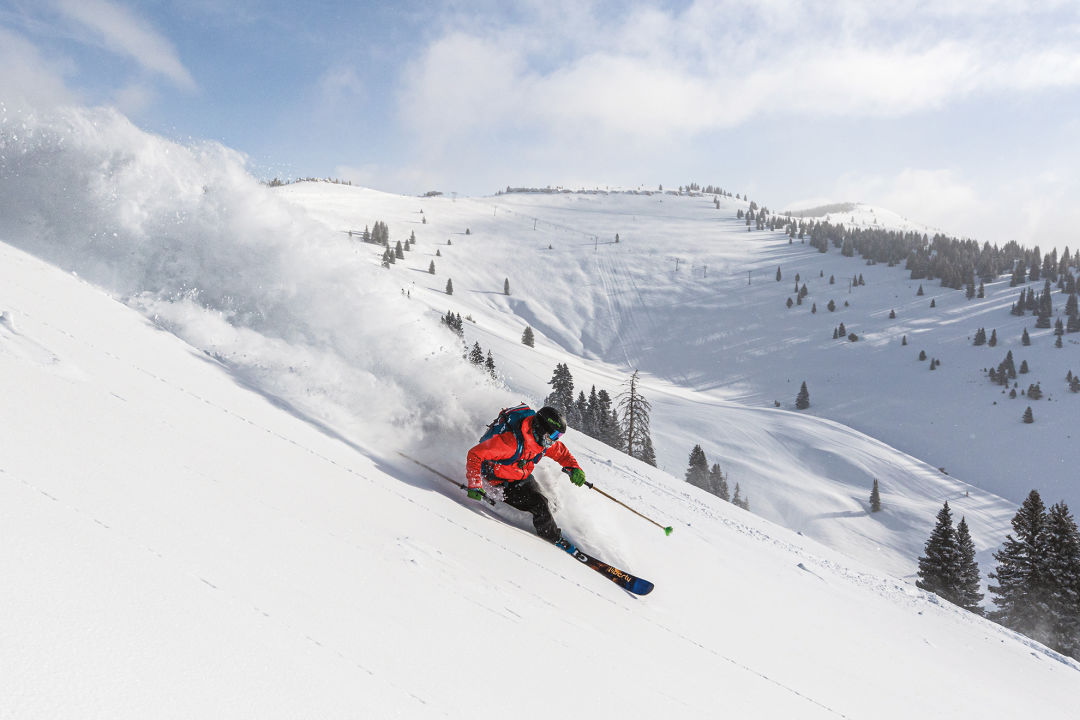
Bennett Levine on China Bowl's Genghis Khan
Image: Scott Bellow
China Bowl
China Bowl’s snow stashes are usually kind of an afterthought on the way to more celebrated powder paradises (like the Siberia Bowl terrain accessible from Chairs 21 and 22—also known as the Orient Express Lift and Mongolia Lift—and, of course, Blue Sky Basin), but that doesn’t mean you can’t get your powder fix while passing through. If you’re up for hucking the cornice (and slashing down sustained steeps), drop into Genghis Khan. Just be prepared for hooting and hollering from Chair 36 (Teacup Express Lift) as you pass under it, especially if you face-plant. Dragon’s Teeth is always a fun detour too, but steer clear of the large cliff band in the middle of the run if you’re not comfortable getting air.
How to get there: Hop on Chair 9 (Sun Up Express Lift) and follow Red Zinger until you see the sign for Genghis Khan on skier’s left. If you decide to attempt Dragon’s Teeth, ride Chair 14 (Sourdough Express Lift) and follow the cat track from Two Elk Lodge around the bowl. If you need to give your legs a rest, you can carve turns down Red Zinger or Poppyfields West, both groomed blue runs, to your final destination.
Teacup Bowl
Teacup Bowl is a fun shortcut to Chair 37 (Skyline Express Lift), which whisks you off to Blue Sky Basin. For a leg-burner that will warm you up—without slowing you down on your way to the very back—cruise down Morning Thunder (beware, there are some small cliff bands in this area, too) and make your way to Marmot Valley, a thick aspen grove intersected by a luge track that deposits you at the base of the lift. Pro tip: if you decide to pass on Marmot Valley, you can hop back onto Sleepytime Road catwalk after you take some turns on Morning Thunder and ride it to the base of either Chair 21 (Orient Express Lift) or to its end at Chairs 36 and 37 (Teacup Express Lift and Skyline Express Lift).
How to get there: From the top of PHQ on the frontside, follow the Sleepytime Road catwalk as it meanders around the rim of Sun Up Bowl. You’ll pass under Chair 9 (Sun Up Express Lift) and arrive at a fork in the road; follow signage for Blue Sky Basin skier’s left.
Sun Down Bowl
Every skier and snowboarder on Vail Mountain has a love-hate relationship with Chair 5 (High Noon Express Lift). What we love: first tracks from the top of the bowl, floating while snow rolls up and over your head. What we hate: lift line gridlock from everyone else who loves that same thing (witness the meme of a Chair 5 lift line seen from space that made the rounds on social media six years ago when thousands of passholders descended on the mountain one particularly snowy Saturday in early January). If you do decide to take the plunge (even with the lines, it’s worth it), consider Ptarmigan Ridge your gateway to pow-town. Riding across the ridge from the top, you can drop into Morning Side Ridge or Ricky’s Ridge for wide-open turns (if it’s first-thing and untouched, you’re in for a bottomless treat), or continue to traverse to the outer reaches of the ridge and hit the slightly-less steep and less-tracked oasis of Never and O.S. (as in “Oh, $#*%!”) before you get funneled to the bottom of the lift. Just remember: if it’s a Saturday and ski patrol is still avy-bombing Blue Sky Basin, you’re probably going to be standing in line for a while when you get there (wave to the satellites if you want in on the next meme).
How to get there: If you ride Chair 3 (Wildwood Express Lift) from Mid-Vail or Chair 7 (Game Creek Express Lift) to the top, you’ll conveniently find yourself atop the bowl. If you’re looking out across the bowl from the top of Chair 7, head down Lost Boy and veer left following signs for Ptarmigan Ridge that will take you across the upper rim of the bowl. Pro tip: Leaving Lost Boy, shoulder your skis and boot-pack it uphill (skier’s right) to the top of Ptarmigan Ridge, the resort’s only hike-to terrain, for a half dozen bonus turns before you drop into Ricky’s.
You ask: "What about all that powder just outside that backcountry gate?"
A little advice when it comes to Vail’s only Poma lift, Chair 22 (Mongolia Lift): you can access the T-bar if you follow the cat track as it veers to the left after departing Chair 21 (Orient Express Lift) to the right at the top of China Bowl. The gate at the top of the lift departs the resort and takes skiers and snowboarders to the East Vail Chutes—a steep, out-of-bounds area that’s not controlled by ski patrol and that’s incredibly avalanche prone. Eight people have died in East Vail (read “Danger Zone” in our Midwinter/Spring 2020 issue), and if you don’t have avalanche equipment (beacon, probe, and shovel), the skills to use said equipment, and a buddy with the same skills and equipment who also knows the area, you have no business exiting the gate (or any other gate you come across on Vail or Beaver Creek mountains for the same reasons). That being said, if you have the good sense to stay inbounds and you still want to ride the T-bar, you’re in for a treat: the wide-open powdery bliss of both Siberia Bowl and Mongolia Bowl.
Blue Sky Basin
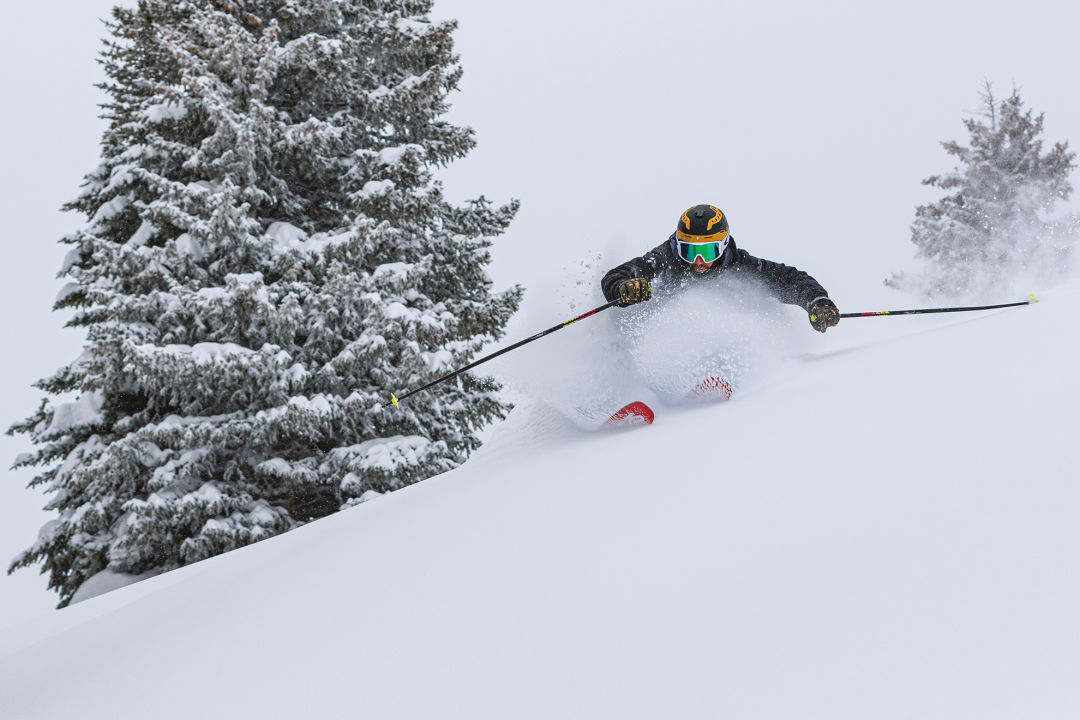
Chris Bivona in Blue Sky Basin's Champagne Glade
Image: Scott Bellow
Chairs 37-39
Other than the time it takes to get there, on a powder day you won’t be disappointed by Blue Sky Basin (just compare Blue Sky’s snowstake to the one at Mid-Vail after any given storm). If you like getting air, taking the plunge off the Lover’s Leap is a no-brainer when the snow is deep (and more forgiving). Also, Hornsilver—skier’s left from the top of Chair 39 (Pete’s Express Lift)—holds good snow days after a storm, and any of the black runs you’ll encounter skier’s right from the top of Chair 37—Steep & Deep, Iron Mask, Little Ollie, and Heavy Metal—are just plain fun for cruising through trees. However, if we’re talking stashes, Champagne Glade in Earl’s Bowl is the pick for powder. It’s sustained and steep, with perfectly placed pines and bumps that tend to collect a deluge of snow that blows down from the ridge separating Vail Mountain from the drainage where Highway 24 cuts through the valley.
How to get there: You can see Champagne Glade off to your right across Earl’s Bowl when you’re riding Chair 37 (Skyline Express Lift) across the ridge; just head right once you get to the top of the lift, skate past Earl’s Express Lift (Chair 38) and look for signs on skier’s right (and, if you’re lucky, an untracked line to drop in).
BEAVER CREEK POWDER STASHES
As a family-friendly resort known for its plethora of green and blue groomers, on a powder day, Beaver Creek provides a pleasant break from the crowds—without sacrificing snow or steeps (this is, after all, home to the Birds of Prey, a fabled course known as North America’s Downhill, where the FIS Alpine World Ski Championships were raced in 2015, and also is a regular stop on the men’s annual World Cup tour). And while Beaver Creek typically doesn’t average quite as much snow as Vail (325 inches of snow annually, compared to Vail’s 365 inches), after a storm when Vail Mountain is overrun with skiers and snowboarders, Beaver Creek can be a powder paradise. You just have to know where to look....
Stone Creek Chutes
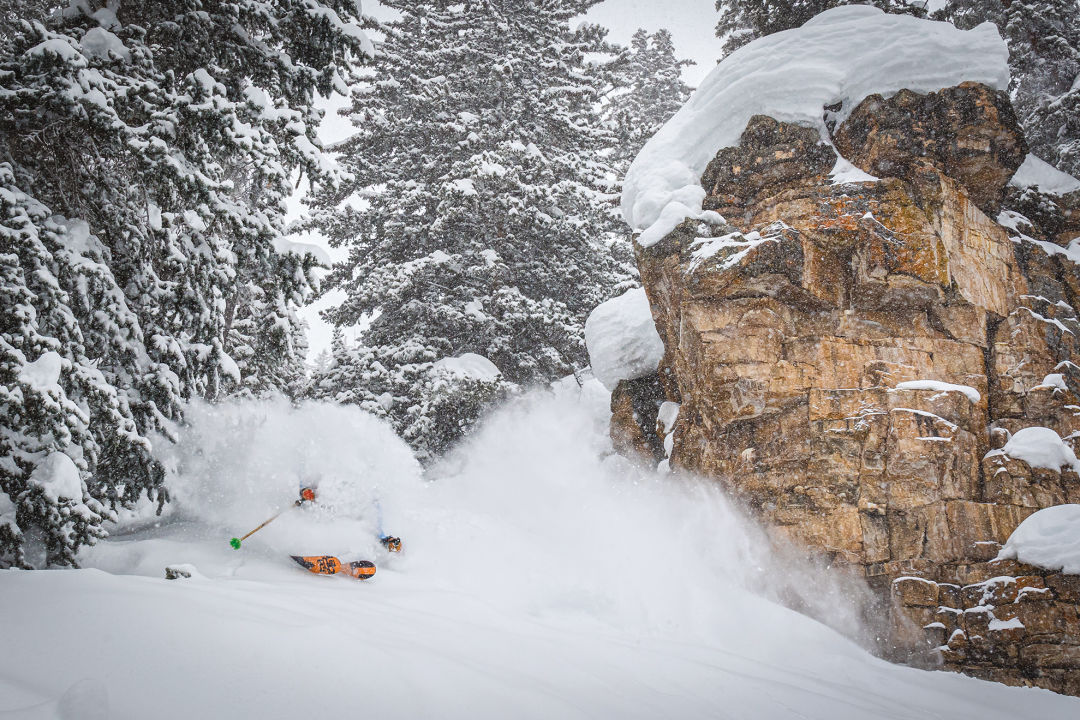
Bennett Levine in Stone Creek Chutes
Image: Scott Bellow
If you’re on a mission to experience the white room at its utmost and you’re comfortable skiing expert terrain, visit Stone Creek Chutes. The area, once out-of-bounds terrain that was added in 2006, typically remains roped-off until there’s enough snow to stick to the steeps. Officially classified as EX (as in “Extreme”) terrain, Stone Creek lives up to its billing: ungroomed, with plenty of powdery pillows, rowdy cliffs, vertiginous pitches (of up to 45 degrees, dropping 400 to 500 vertical feet), and glades to poach. Pick any of four separate entrances—two in the “Upper Stone Creek Chutes” (First Chance and Second Chance) and two in the “Lower Stone Creek Chutes” (Half Chance and No Chance), the biggest difference being that the upper entrances offer a longer run out (and the opportunity for more face shots while you work your way out).
How to get there: From the top of either Red Buffalo Express (Chair 5) or Cinch Express (Chair 8) lifts, head skier’s right and hug the rope line as you cruise down the green run Red Buffalo. Keep your eyes peeled; each entrance to the chutes is labeled with a sign warning of “Extreme Terrain,” and if it’s closed, heed the warning—this area slides and it’s closed for a reason.
Strawberry Park
If you’re not into steeps but you love untracked tree skiing, Thresher Glade is your sure thing—as long as you are confident maneuvering through thick stands of pine and aspen. Nearby, a surprisingly fun and short stretch of steep mogul fields (President Fords and Stacker) provide ample opportunity for thigh-burning pillowy powder turns. On the morning of a powder day, as a warmup to Stone Creek and Birds of Prey, your plan should be to take turns on all three, and multiple laps on the lift, which glides right over the former home of Gerald R. Ford, who kept the Secret Service busy while frequenting his backyard powder playground.
How to get there: From the top of the Upper Beaver Creek Express Lift (Chair 18) or Strawberry Park Express Lift (Chair 12), exit skier's left and follow the cat track toward Larkspur Bowl, then veer left, following signs to President Ford's and Thresher Glade.
Birds of Prey
If you like steeps, and a challenge, there’s nothing quite steeper, or more challenging, at Beaver Creek than charging down Golden Eagle from the start of the Birds of Prey Men’s Downhill Course at the top of Upper Golden Eagle. After World Cup racing has ended, the downhill, an injected course of sheer ice, reverts to snow that is groomed regularly, but if you hop off the lift on a day the groomers haven’t gotten to it (and it just snowed a foot or more), make sure you take a lap for an unforgettable high-speed downhill float you’ll be reliving well into summer. And for perspective while you’re huffing and puffing your way down: American ski racer Daron Rahlves registered the course’s fastest time in 2003—the year before he and Bode Miller went 1 and 2 at the event—when he crossed the finish in just under a minute and 40 seconds.
How to get there: From the mountain’s base, hop on the Centennial Express Lift (Chair 6) and transfer to the Cinch Express Lift (Chair 8). From the top of the Cinch Express, veer skier’s right above terrain park to signs for the Men’s Birds of Prey Downhill Course Start, your launchpad into double-black bliss.
Larkspur Bowl
While Beaver Creek scours the powder out of its two shallow bowls to make the mountain more groomer-friendly for intermediate skiers, a trio of steep but short bump runs on Larkspur Bowl’s eastern flank (Loco, Shooting Star, and Lupine) offer a powder-day respite from the masses of beginners ping-ponging down the bowl’s namesake groomer.
How to get there: From the top of the Upper Beaver Creek Express Lift (Chair 18) or Strawberry Park Express Lift (Chair 12), exit skier's left and follow the cat track and signs to Larkspur Bowl.
Grouse Mountain
While everyone knows Grouse Mountain is where you go to ski blacks (mainly because all the runs found here are blacks), Royal Elk Glade and Black Bear Glade on the resort’s western boundary are some of the Beav’s thickest pockets of trees where you’ll find some of the mountain’s deepest snow. Just be prepared to traverse back to the lift down a long cat track once you hit the bottom—trust us, it’s worth it.
How to get there: You can see Grouse Mountain and its lift to your right as you ride the Centennial Express Lift (Chair 6) from the mountain base; once you hop off the Centennial Express, follow West Fall Road on skier’s right to the blue Red Tail run to the Talons base area and the bottom of the Grouse Mountain Express Lift (Chair 10). At the top of Grouse Mountain, exit skier’s right and follow the narrow, signed path to reach Royal Elk Glade and Black Bear Glade.
ATHLETE PROFILES
Chris Bivona
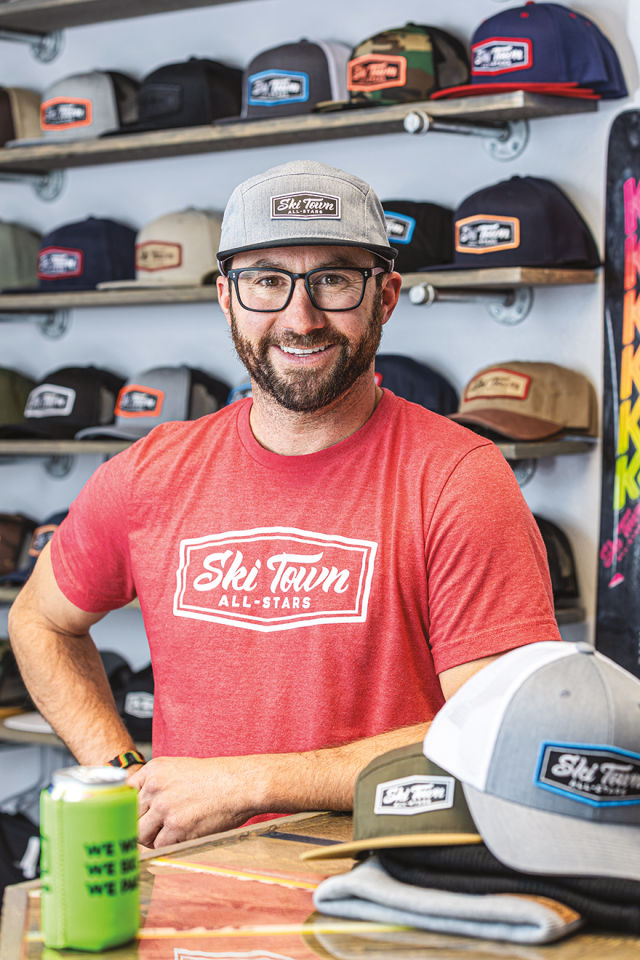
He moved to the valley six years ago after relocating from the East Coast, and a brief stint in Lake Tahoe. When he’s not on the mountain he’s running Ski Town All-Stars, a company he founded out of his kitchen that sells (and sews) beanies, custom tees, and trucker hats emblazoned with catchy ski phrases (among his best sellers are “Send It” and “Trump Skis in Jeans”). Bivona recently upgraded to a full-blown workspace and showroom in East Vail (3971 Big Horn Rd; 973-525-6123, skitownall
stars.com), where you can also pick up prints from our feature photographer, Scott Bellow (scottbellow.com). If you stop by, just respect the ski-friendly hours—“9ish to 5ish,” as dictated by the snowstake—posted on the door.
Gus Gruner
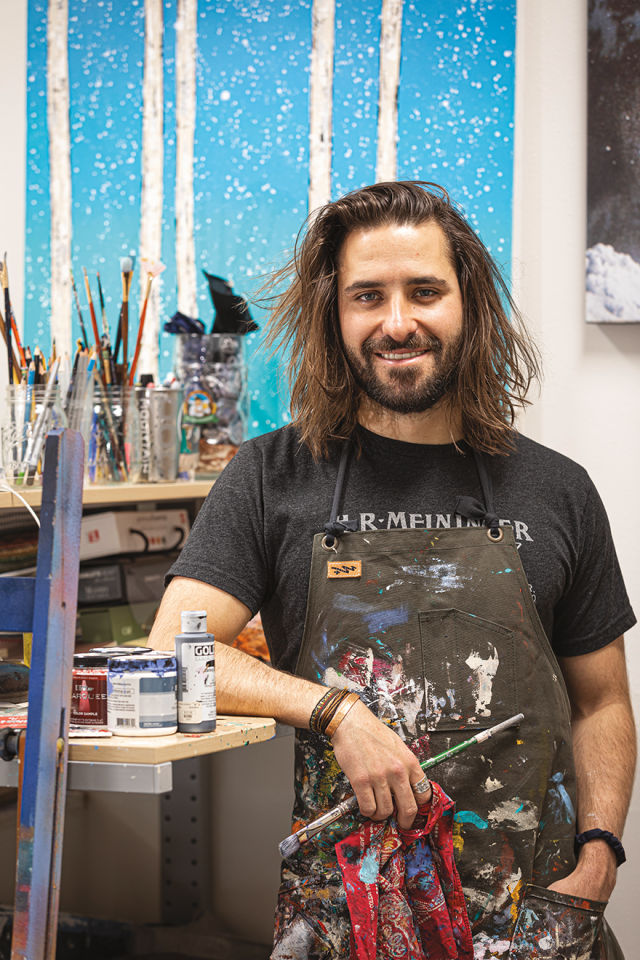
He moved to the valley seven years ago from New York, and when it didn’t stop snowing that first winter, he decided not to leave.
When he’s not on the mountain he’s a working artist who creates colorful canvases from his gallery space in the Mountain Art Collective (see “Creative Collective,” p. 101), and in the summer, he sells them from his booth at the Vail Farmers Market and Art Show.
Bryan Finocchiaro
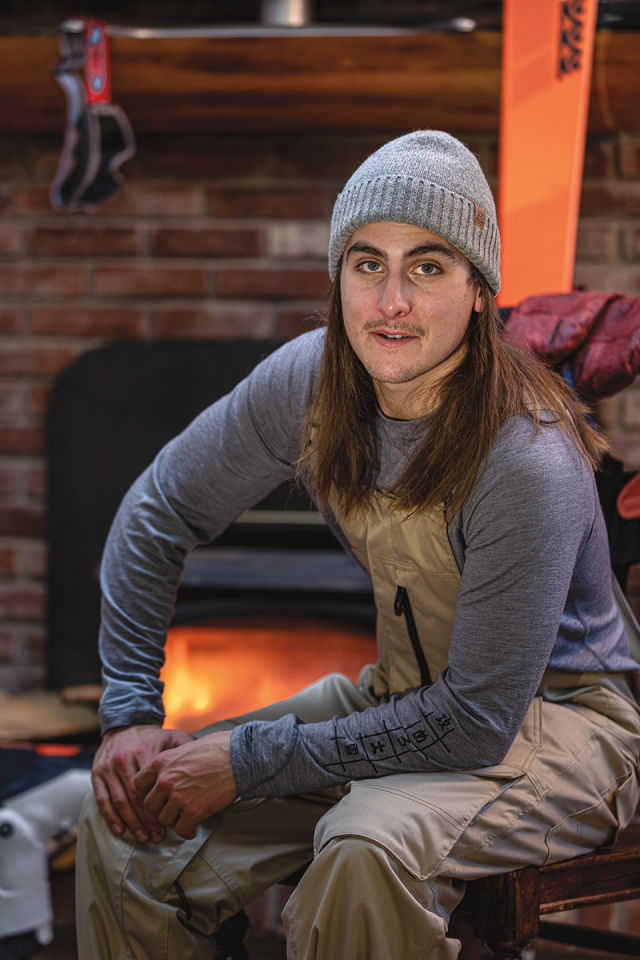
He moved to the valley the year after Gus Gruner—funny story, the two were roommates at college in New Hampshire and skied together on the East Coast.
When he’s not on the mountain he’s on another mountain, and probably skiing. As of press time, he was headed to Japan, where he’s spent the last three Januaries poaching powder around the island of Hokkaido.
Bennett Levine

He moved to the valley on February 16, 2012—two days after a buddy called him and said he had a job waiting for him in Vail if he wanted it. His parents had a place in Lionshead Village when he was a kid, so he didn’t need much convincing.
When he’s not on the mountain he’s—more recently—adjusting to life working 9 to 5 for local CBD company Millie (that’s cannabidiol that you rub on sore muscles—not THC that you smoke), but he’s optimistic that the new start time shouldn’t stop him from catching first chair whenever Vail or Beaver Creek report more than six inches of fresh powder.







































